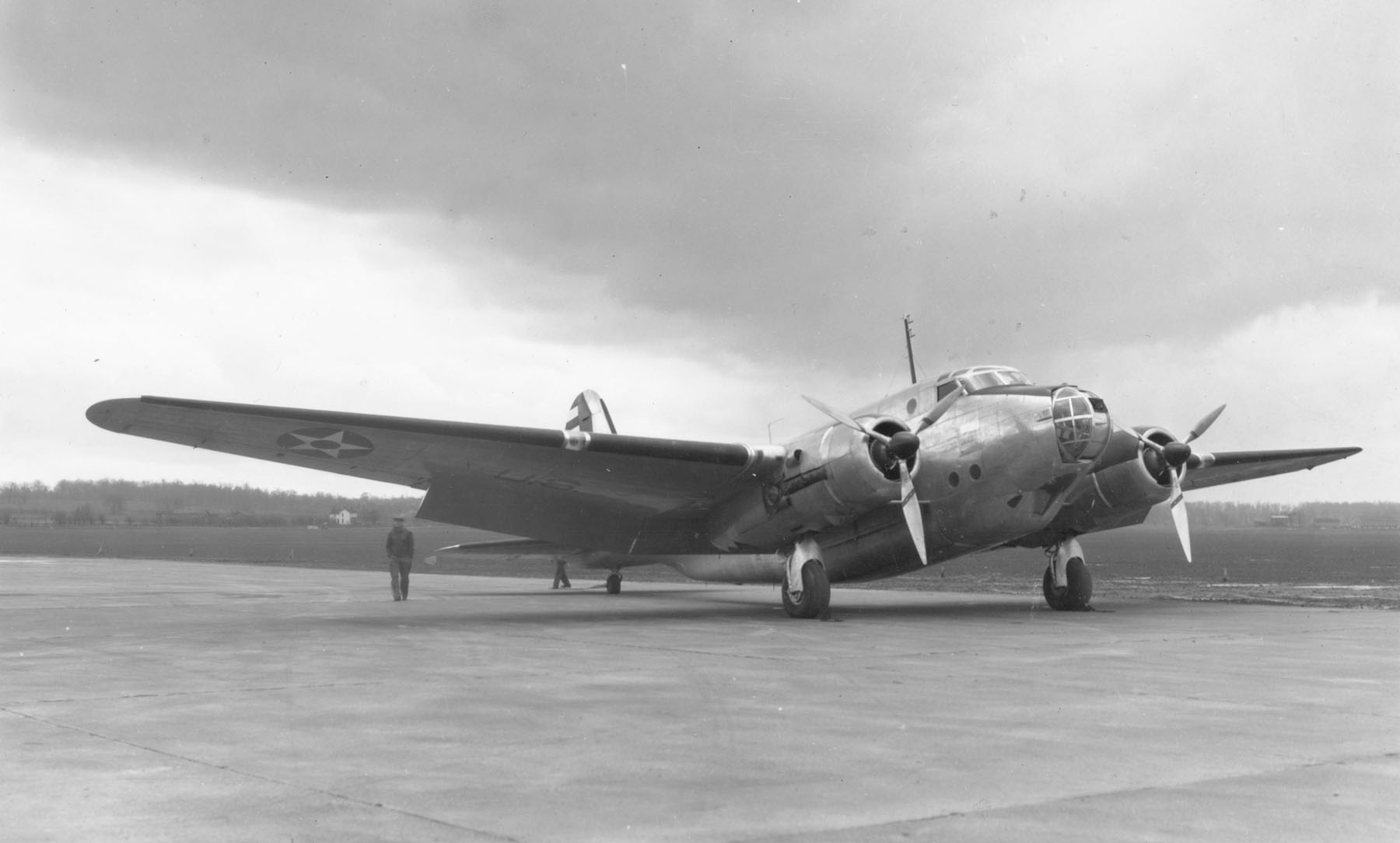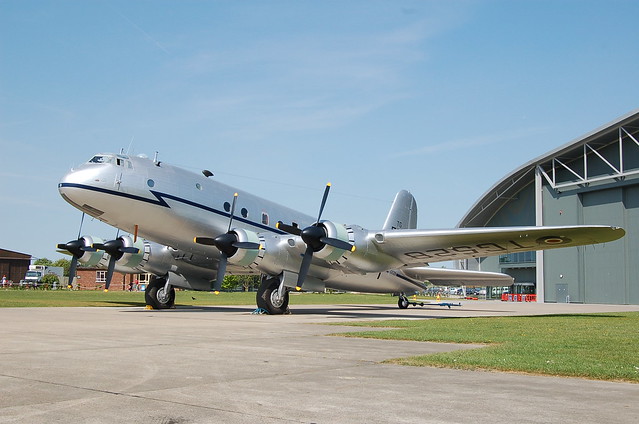You are using an out of date browser. It may not display this or other websites correctly.
You should upgrade or use an alternative browser.
You should upgrade or use an alternative browser.
Lancaster and Halifax with tricycle landing gear
- Thread starter PMN1
- Start date
SwampTiger
Banned
Need to shift main gear aft of COG, thus moving wings. Would be a total redesign. The basic concept is there, but not used by British aviation.
It's not going to do anything operationally other than add weight to the aircraft and so reduce either range or bombload.
Avro designed the Type 680 to spec B.1/39. It's similar in many respects to the Manchester/Lancaster/Lincoln/Shackleton family but has a different wing planform, twin wheel maingear and a nosegear. If anything, I'd say it was a Shackleton MR3 20 years early.
Need to shift main gear aft of COG, thus moving wings. Would be a total redesign. The basic concept is there, but not used by British aviation.
Sorry, I meant from the start.
Yes it was not use in British aviation at the time but three years later all the 15.38 airliner specs and all B1.39 bomber specs used tricycle undercarriage and Shorts was looking at it for its 15/38 spec, so most of the British aviation industry had decided this is the way to go, so what can be done to make that happen sooner?
MatthewB
Banned
We need wider acceptance and use of the Armstrong Whitworth Albemarle, first flown in early 1940. The mock-up was shown to the Air Ministry in 1938, well in time to influence the Lancaster and Halifax designs. I suppose the tricycle setup makes for easier torpedo and bomb loading.What would it take for the Lancaster and the Halifax to have tricycle landing gear rather than tail wheel landing gear?

Maybe Armstrong influenced the later North American B-25 Mitchell design.


Last edited:
marathag
Banned
This was the NAA XB-21 from 1937Maybe Armstrong influenced the later Mitchell B-25 design.

This was a competitor to the B-18 Bolo, turbocharged Hornets, and a 5 ton bombload with two powered turrets.
But it cost around twice of what Douglas was selling the B-18, but still half of what Boeing was getting for the B-17A
Only one built.
Quite a change from this to the B-25
MatthewB
Banned
That’s what got me thinking. The RAF has the first tricycle undercarriage twin tail bomber in mock-up form in 1938, and then two years later North American has the same config, seemingly out of nowhere. According to Wikipedia, the B-25 was first intended for export to Britain and France, so presumably North American checked out what was then being developed for RAF service.This was the NAA XB-21 from 1937

This was a competitor to the B-18 Bolo, turbocharged Hornets, and a 5 ton bombload with two powered turrets.
But it cost around twice of what Douglas was selling the B-18, but still half of what Boeing was getting for the B-17A
Only one built.
Quite a change from this to the B-25
Last edited:
MatthewB
Banned
Obviously the Albemarle didn’t impress, as the RAF didn’t field another tricycle level bomber until the jet-powered V-bombers or the later versions of the Avro Shackleton. I believe in 1945 the tricycle-equipped Handley Page HP.81 Hermes became the first British airliner so equipped.
Not that tricycle level bombers were popular with the other powers, Japan for example has the Nakajima G8N Renzan, but not much else. AFAIK, Russia, Italy and France didn’t field any tricycle level bombers.
Not that tricycle level bombers were popular with the other powers, Japan for example has the Nakajima G8N Renzan, but not much else. AFAIK, Russia, Italy and France didn’t field any tricycle level bombers.
Last edited:
MatthewB
Banned
True that, beating the V-bombers by some years. That said, I believe the Shackleton, albeit with Coastal, not Bomber Command, is the RAF’s next tricycle-equipped level bomber after the Albermarle.Erm, Canberra?
Though I’m not sure when they went from this...

To this...

The Shackleton’s conversion from taildragger to tricycle does give us some idea on the feasibility of a similar design change to the Lancaster and Halifax.
Question on undercarriage type and the Avro Tudor. and initial versions of the Shackleton.
Avro’s bid for B1.39 had a tricycle undercarriage which suggests that they thought they could use this undercarriage.
The Tudor used as many components of the Lincoln as possible but used a new fuselage where the wing location could be chosen, so why did they choose a tailwheel undercarriage for this aircraft?
Same goes for the initial version of the Shackleton....a new fuselage where wing location could be chosen, so why did they choose a tailwheel undercarriage for initial versions of this aircraft?
Avro’s bid for B1.39 had a tricycle undercarriage which suggests that they thought they could use this undercarriage.
The Tudor used as many components of the Lincoln as possible but used a new fuselage where the wing location could be chosen, so why did they choose a tailwheel undercarriage for this aircraft?
Same goes for the initial version of the Shackleton....a new fuselage where wing location could be chosen, so why did they choose a tailwheel undercarriage for initial versions of this aircraft?
Question on undercarriage type and the Avro Tudor. and initial versions of the Shackleton.
Avro’s bid for B1.39 had a tricycle undercarriage which suggests that they thought they could use this undercarriage.
The Tudor used as many components of the Lincoln as possible but used a new fuselage where the wing location could be chosen, so why did they choose a tailwheel undercarriage for this aircraft?
Same goes for the initial version of the Shackleton....a new fuselage where wing location could be chosen, so why did they choose a tailwheel undercarriage for initial versions of this aircraft?
For the Tudor - and I imagine the Shatipuss too - they were designed that way as that's what the customers (BOAC, even though they fucked Avro about royally and the RAF) wanted. I have seen reference to, but have yet to see any official drawings, of a nosegear Tudor for freight transport - I *think* it's the Type 711 Trader. I'd imagine that it'd be based somewhat on the work done on converting the extant Tudor airframes into the Ashton research aircraft and utilising the revised wing and u'c arrangement of the Shackleton MR3. I've been toying with doing one in 72nd by crosskitting a Magna Ashton with the wings and u/c of a Frog Shackleton.
Info on Avro Tudor here:
http://britishaviation-ptp.com/avro688.html
I found this drawing for the Trader during a google search but have yet to see anything official for it to be based on, so best treated as speculative.

Interestingly, the same search turned up a page with some info on possible Australian production of the Tudor for the RAAF.
MatthewB
Banned
This reminds me of the transition from taildragger Handley Page Hastings to tricycle Hermes. There’s no reason that both aircraft couldn’t be in service in 1940, albeit with different engines.For the Tudor - and I imagine the Shatipuss too - they were designed that way as that's what the customers (BOAC, even though they fucked Avro about royally and the RAF) wanted. I have seen reference to, but have yet to see any official drawings, of a nosegear Tudor for freight transport - I *think* it's the Type 711 Trader. I'd imagine that it'd be based somewhat on the work done on converting the extant Tudor airframes into the Ashton research aircraft and utilising the revised wing and u'c arrangement of the Shackleton MR3. I've been toying with doing one in 72nd by crosskitting a Magna Ashton with the wings and u/c of a Frog Shackleton.
Info on Avro Tudor here:
http://britishaviation-ptp.com/avro688.html
I found this drawing for the Trader during a google search but have yet to see anything official for it to be based on, so best treated as speculative.

Interestingly, the same search turned up a page with some info on possible Australian production of the Tudor for the RAAF.


they were designed that way as that's what the customers (BOAC, even though they fucked Avro about royally
BOAC and BEA seem to have jointly decided to fuck British aircraft manufacturers about. Monday we want a 100 seater with 2 engines draughtsmen get busy, Tuesday we have changed our minds we want an 80 seater with smaller engines draughtsmen get busier, Wednesday we have changed our minds again we want a 120 seater with 3 engines draughtsmen go bald, Thursday we want the exact same aircraft we wanted on Monday but in a different colour and slightly wider and shorter draughtsmen get mondays plans out redraw it and give it a new name, Friday "This is the BBC 6 o'clock news BOAC announce there new Boeing 100 seat twin engine plane. British aircraft manufacturers go to the pub to get hammered.
marathag
Banned
Consolidated B-24. Multiwheel sets started with heavier aircraftI notice that whenever there’s tricycle undercarriage on the four engine and large aircraft there are multi sets of main wheels. Whereas on taildraggers there’s usually only two large wheels.
MatthewB
Banned
I wasn't challenging anyone to find the exceptions. I'm only observing that most have single main wheelsConsolidated B-24. Multiwheel sets started with heavier aircraft
marathag
Banned
It was just overall weight. Otherwise you got very heavy single wheels, like the XB-36 had.I wasn't challenging anyone to find the exceptions. I'm only observing that most have single main wheels
I think the DC-4, first flown in 1942, with duals on the main gear, a change from the pre-war DC-4E
The Tudor used as many components of the Lincoln as possible but used a new fuselage where the wing location could be chosen, so why did they choose a tailwheel undercarriage for this aircraft?
Passengers enter by a tail door which is close to the ground?
Share: